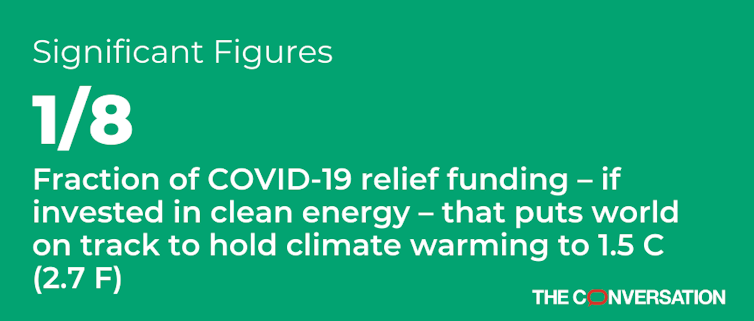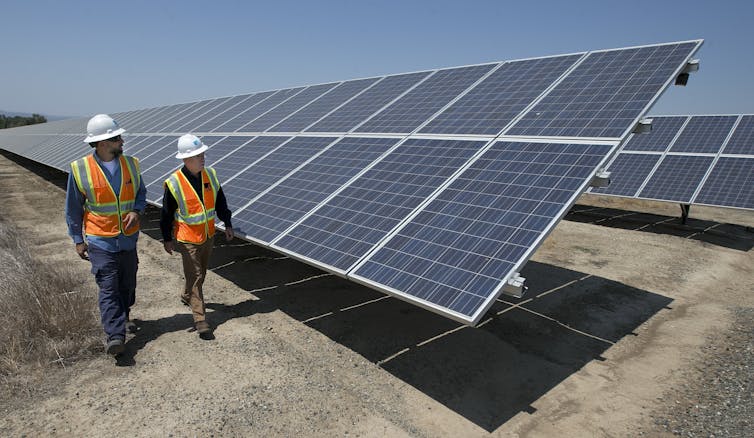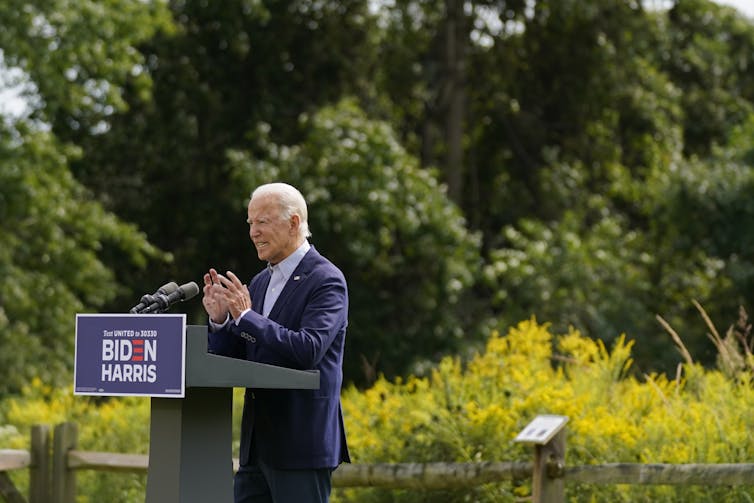Coronavirus relief funds could easily pay to stop the worst of climate change while rebooting economies
- Written by David L. McCollum, Senior Research Scientist, University of Tennessee
 CC BY-ND[1]
As of late summer, governments around the world[2] had pledged US$12.2 trillion of relief[3] in response to the coronavirus pandemic. That’s around 15% of global GDP[4], three times larger than government spending put forward during and after the 2008-2009 global financial crisis and enough for every adult in the world to receive a $2,000 check.
A good chunk of initial COVID-19 aid funding is being used – quite rightly – to support health care systems, preserve people’s livelihoods and stabilize employment. But much is slated for investment into infrastructure and economies[5]. Whether those are climate-friendly investments or not still remains to be seen[6].
While the world’s bout with the virus is far from over, there is already talk amongst leaders like Joe Biden[7] and Boris Johnson[8] about rebuilding toward a more sustainable, more resilient future.
The global economic rebuild could include efforts to avoid the worst impacts of one of today’s looming mega-threats: climate change.
Money needed to achieve climate goals
Moving toward a cleaner energy world is cheaper than many people perceive[9].
My work at the Electric Power Research Institute, University of Tennessee and with the Intergovernmental Panel on Climate Change focuses on the costs and benefits of energy and climate decisions[10] made by governments and companies.
According to research done by me and my colleagues, we estimate it would cost around $1.4 trillion per year over the next five years[11] in clean-energy investment to meet the goals of the Paris climate agreement. This amount – if invested around the globe in things like solar and wind power, advanced power grids, carbon capture and storage, biofuels, electric vehicles, better insulated homes and other carbon-saving efforts – would start to bend the emissions curve, putting the world on a path to net-zero emissions by midcentury.
In other words, it is by no means impossible to hold global temperature rise to +1.5 C (2.7 F)[12].
CC BY-ND[1]
As of late summer, governments around the world[2] had pledged US$12.2 trillion of relief[3] in response to the coronavirus pandemic. That’s around 15% of global GDP[4], three times larger than government spending put forward during and after the 2008-2009 global financial crisis and enough for every adult in the world to receive a $2,000 check.
A good chunk of initial COVID-19 aid funding is being used – quite rightly – to support health care systems, preserve people’s livelihoods and stabilize employment. But much is slated for investment into infrastructure and economies[5]. Whether those are climate-friendly investments or not still remains to be seen[6].
While the world’s bout with the virus is far from over, there is already talk amongst leaders like Joe Biden[7] and Boris Johnson[8] about rebuilding toward a more sustainable, more resilient future.
The global economic rebuild could include efforts to avoid the worst impacts of one of today’s looming mega-threats: climate change.
Money needed to achieve climate goals
Moving toward a cleaner energy world is cheaper than many people perceive[9].
My work at the Electric Power Research Institute, University of Tennessee and with the Intergovernmental Panel on Climate Change focuses on the costs and benefits of energy and climate decisions[10] made by governments and companies.
According to research done by me and my colleagues, we estimate it would cost around $1.4 trillion per year over the next five years[11] in clean-energy investment to meet the goals of the Paris climate agreement. This amount – if invested around the globe in things like solar and wind power, advanced power grids, carbon capture and storage, biofuels, electric vehicles, better insulated homes and other carbon-saving efforts – would start to bend the emissions curve, putting the world on a path to net-zero emissions by midcentury.
In other words, it is by no means impossible to hold global temperature rise to +1.5 C (2.7 F)[12].
 Investments in low-carbon energy production, like solar, as well as energy efficiency improvements, can do much to reduce carbon emissions.
AP Photo/Rich Pedroncelli[13]
A lot is already being spent on climate initiatives
While $1.4 trillion per year sounds like a lot of money, it’s actually not so much greater than what is already being spent on clean energy worldwide.
Countries are projected to invest an estimated $1.1 trillion per year[14] over the next five years into low-carbon energy strategies. This pathway would take the world toward 3 degrees Celsius of warming[15], a level that could be quite harmful for the planet[16].
Much of this funding comes in response to national, state and local[17] policy mandates and incentives. But a lot is happening thanks to pure economics[18] as well: companies aiming to profit from new clean energy installations, which are becoming increasingly more affordable in many places.
Thus, taking into account the $1.1 trillion per year baked into the system already, the additional amount of clean energy investment needed to get on a 1.5 C track comes to just $0.3 trillion – or $300 billion – per year over the next five years.
For the entire globe, $300 billion per year over five years – or $1.5 trillion cumulative – is not an outrageous sum of money. It represents just one-eighth of the $12.2 trillion governments around the world have announced for COVID-19 relief to date.
Thus, a fraction of current bailout funding could provide the extra near-term boost the world needs to get on track to meet +2 or 1.5 C (+3.6 or 2.7 F) of warming, the levels countries committed to in the 2015 Paris climate agreement[19].
Investments in low-carbon energy production, like solar, as well as energy efficiency improvements, can do much to reduce carbon emissions.
AP Photo/Rich Pedroncelli[13]
A lot is already being spent on climate initiatives
While $1.4 trillion per year sounds like a lot of money, it’s actually not so much greater than what is already being spent on clean energy worldwide.
Countries are projected to invest an estimated $1.1 trillion per year[14] over the next five years into low-carbon energy strategies. This pathway would take the world toward 3 degrees Celsius of warming[15], a level that could be quite harmful for the planet[16].
Much of this funding comes in response to national, state and local[17] policy mandates and incentives. But a lot is happening thanks to pure economics[18] as well: companies aiming to profit from new clean energy installations, which are becoming increasingly more affordable in many places.
Thus, taking into account the $1.1 trillion per year baked into the system already, the additional amount of clean energy investment needed to get on a 1.5 C track comes to just $0.3 trillion – or $300 billion – per year over the next five years.
For the entire globe, $300 billion per year over five years – or $1.5 trillion cumulative – is not an outrageous sum of money. It represents just one-eighth of the $12.2 trillion governments around the world have announced for COVID-19 relief to date.
Thus, a fraction of current bailout funding could provide the extra near-term boost the world needs to get on track to meet +2 or 1.5 C (+3.6 or 2.7 F) of warming, the levels countries committed to in the 2015 Paris climate agreement[19].
 President-elect Joe Biden has proposed large investments into clean energy.
AP Photo/Patrick Semansky[20]
Change course, then move forward
President-elect Joe Biden is calling for some $1.7 trillion investment in clean energy and energy efficiency[21] over the next 10 years. This level of investment, if also realized in other countries, could put the world on a path to meeting the goals of the Paris Agreement.
The U.S. has already committed trillions of dollars for COVID-19 relief, much of which is going toward important needs like patient care, vaccine research and direct economic bailouts. But economic recovery plans contain money for long-term economic growth, too[22]. And that’s the money I am suggesting could be directed toward climate-friendly investments.
Meeting the Paris goals will ultimately demand continued and increasing investments going forward[23], climbing above the $300 billion per year over the next five years that would get the world on track to 1.5 C (2.7 F). Nevertheless, an initial injection of funds into clean energy could achieve two goals: boost the global economy through large infrastructure spending and accelerate the deployment of clean energy production and energy efficiency measures.
[Deep knowledge, daily. Sign up for The Conversation’s newsletter[24].]
Like with so many things, the question seems to be one of political will – are governments and companies willing and able to turn toward a cleaner, more prosperous future to the benefit of all?
Public funding appears to be available – for now – and given how massive this funding is, it provides a unique opportunity to catalyze the development, deployment and dissemination of clean technologies[25] during the next decade, an absolutely critical period in the fight against climate change.
President-elect Joe Biden has proposed large investments into clean energy.
AP Photo/Patrick Semansky[20]
Change course, then move forward
President-elect Joe Biden is calling for some $1.7 trillion investment in clean energy and energy efficiency[21] over the next 10 years. This level of investment, if also realized in other countries, could put the world on a path to meeting the goals of the Paris Agreement.
The U.S. has already committed trillions of dollars for COVID-19 relief, much of which is going toward important needs like patient care, vaccine research and direct economic bailouts. But economic recovery plans contain money for long-term economic growth, too[22]. And that’s the money I am suggesting could be directed toward climate-friendly investments.
Meeting the Paris goals will ultimately demand continued and increasing investments going forward[23], climbing above the $300 billion per year over the next five years that would get the world on track to 1.5 C (2.7 F). Nevertheless, an initial injection of funds into clean energy could achieve two goals: boost the global economy through large infrastructure spending and accelerate the deployment of clean energy production and energy efficiency measures.
[Deep knowledge, daily. Sign up for The Conversation’s newsletter[24].]
Like with so many things, the question seems to be one of political will – are governments and companies willing and able to turn toward a cleaner, more prosperous future to the benefit of all?
Public funding appears to be available – for now – and given how massive this funding is, it provides a unique opportunity to catalyze the development, deployment and dissemination of clean technologies[25] during the next decade, an absolutely critical period in the fight against climate change.
References
- ^ CC BY-ND (creativecommons.org)
- ^ governments around the world (www.imf.org)
- ^ US$12.2 trillion of relief (doi.org)
- ^ global GDP (data.worldbank.org)
- ^ investment into infrastructure and economies (www.theguardian.com)
- ^ still remains to be seen (www.theguardian.com)
- ^ Joe Biden (joebiden.com)
- ^ Boris Johnson (www.theguardian.com)
- ^ cheaper than many people perceive (ar5-syr.ipcc.ch)
- ^ focuses on the costs and benefits of energy and climate decisions (scholar.google.com)
- ^ $1.4 trillion per year over the next five years (doi.org)
- ^ global temperature rise to +1.5 C (2.7 F) (www.ipcc.ch)
- ^ AP Photo/Rich Pedroncelli (newsroom.ap.org)
- ^ $1.1 trillion per year (doi.org)
- ^ 3 degrees Celsius of warming (climateactiontracker.org)
- ^ quite harmful for the planet (ar5-syr.ipcc.ch)
- ^ national, state and local (doi.org)
- ^ pure economics (www.popularmechanics.com)
- ^ Paris climate agreement (unfccc.int)
- ^ AP Photo/Patrick Semansky (newsroom.ap.org)
- ^ $1.7 trillion investment in clean energy and energy efficiency (joebiden.com)
- ^ long-term economic growth, too (www.theguardian.com)
- ^ continued and increasing investments going forward (doi.org)
- ^ Sign up for The Conversation’s newsletter (theconversation.com)
- ^ development, deployment and dissemination of clean technologies (www.climateworks.org)
Authors: David L. McCollum, Senior Research Scientist, University of Tennessee


